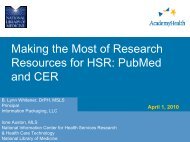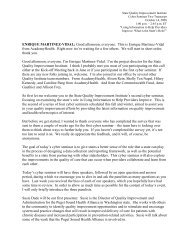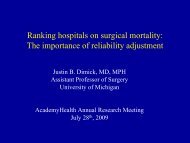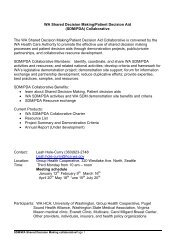Ohio Health Quality Improvement Plan
Ohio Health Quality Improvement Plan
Ohio Health Quality Improvement Plan
You also want an ePaper? Increase the reach of your titles
YUMPU automatically turns print PDFs into web optimized ePapers that Google loves.
Appendix II — Response to QuestionsAt the <strong>Ohio</strong> <strong>Health</strong> <strong>Quality</strong> <strong>Improvement</strong> Summit Part II,held April 27, 2009, questions were asked related to specificrecommendations as well as several general topics orcross-cutting issues. In response to these questions, modificationsor clarifications have been made where appropriateto the plan. Below we have noted some of the mostfrequently raised comments that we received at the Summitand through the subsequent survey replies.Reduction of <strong>Health</strong> DisparitiesThe reduction of health disparities remains a critical issue.The November 2008 OHQIS identified health disparities asa cross-cutting topic to be addressed by each strategic focusarea. Recognizing the crucial role reducing health disparitieswill play in an overall transformation of <strong>Ohio</strong>’s healthcare system, an ad hoc, public-private work group wascreated shortly after the Summit to specifically focus onthe issue. Given the size and scope of the topic, recommendationswere not completed in time to be reviewed at theSummit Part II (April 27, 2009). However, recommendedtactics developed by the work group have been consideredand incorporated in each Collaborative TransformationalStrategy. In addition, these and other tactics to address andreduce disparities will continue to be developed as part ofthe <strong>Health</strong> Care Coverage and <strong>Quality</strong> Council’s (HCCQC)work to identify priorities and facilitate implementation ofthe <strong>Plan</strong>. The Council’s diverse membership will assureongoing consideration of the issue and will work with theOffice of <strong>Health</strong>y <strong>Ohio</strong> and the <strong>Ohio</strong> Department of <strong>Health</strong>,in particular the state’s dedicated <strong>Health</strong> Equity Coordinator,to coordinate efforts.<strong>Health</strong> Promotion/Prevention of Diseaseand InjurySeveral comments were received related to the apparentabsence of strategies and tactics related to the promotion ofhealth and prevention of disease and injury, a topic that hadbeen a Strategic Focus Area at the November Summit.incorporate, and align related activities, since there is broadrecognition that addressing this area will contribute notonly to improving health, but also the reduction of unnecessarymedical expenditures. In addition, CTS strategiessuch as payment reform, the medical home, and informedindividuals each incorporate components of health promotionand disease prevention.Patient SafetyWe also received comments reinforcing Summit participants’desire to address patient safety concerns across thecare continuum. This, too, had been a Strategic FocusArea at the November Summit. In honing initial prioritiesfor the draft plan, team members noted that there aremany existing groups across the state already workingextensively to improve patient safety. For example, the<strong>Ohio</strong> Patient Safety Institute – a collaborative effort of the<strong>Ohio</strong> Hospital Association, <strong>Ohio</strong> State Medical Association,and <strong>Ohio</strong> Osteopathic Association – has many activeinitiatives with proven track records for improving patientsafety and reducing errors. There are also several statewideand regional safety-focused hospital collaborativescurrently underway across the state led by groups like the<strong>Ohio</strong> Hospital Association, the <strong>Ohio</strong> Business Roundtable,Cardinal <strong>Health</strong> Foundation, the <strong>Ohio</strong> Children’s HospitalAssociation, regional health and hospital associations, andother groups. In addition, many <strong>Ohio</strong> health care institutionshave ongoing initiatives focused on improving patientsafety that have been nationally recognized for their success.In many cases, these initiatives align directly with therecommendations developed by the Patient Safety StrategicFocus Area work team and Summit participants. Nonetheless,in developing the Collaborative TransformationalStrategies and draft work plan, the work team and Summitparticipants’ recommendations were considered, andseveral of these recommendations were embedded in thetactics for each of the four CTS strategies.As noted in the <strong>Plan</strong>’s discussion of the CollaborativeTransformational Strategies, one of the criteria used toidentify the focus areas was whether the strategy had anexisting institutional home providing direction and leadership.In the case of health promotion and disease/injuryprevention, such a home exists in the Office of <strong>Health</strong>y<strong>Ohio</strong>, located at the <strong>Ohio</strong> Department of <strong>Health</strong>. The HC-CQC will continue to work with <strong>Health</strong>y <strong>Ohio</strong> to consider,27










